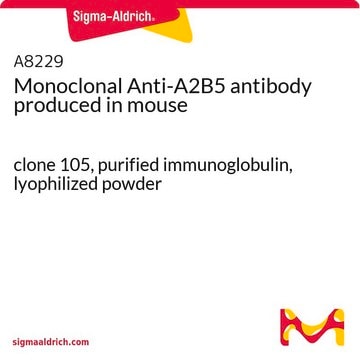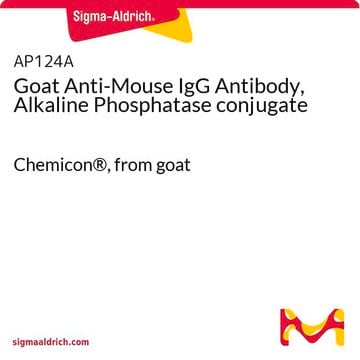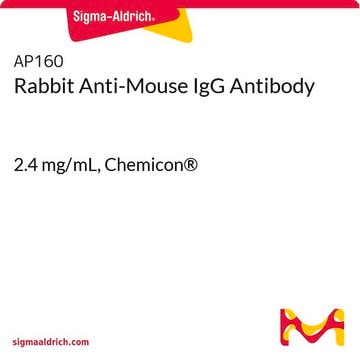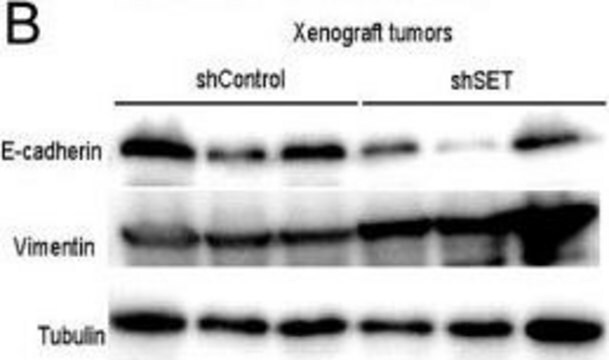MAB312R
Anti-A2B5 Antibody, clone A2B5-105
clone A2B5-105, Chemicon®, from mouse
Sinonimo/i:
Neuron Cell Surface Antigen
Scegli un formato
Scegli un formato
About This Item
Prodotti consigliati
Origine biologica
mouse
Livello qualitativo
Forma dell’anticorpo
saturated ammonium sulfate (SAS) precipitated
Tipo di anticorpo
primary antibodies
Clone
A2B5-105, monoclonal
Reattività contro le specie (prevista in base all’omologia)
mammals
Produttore/marchio commerciale
Chemicon®
tecniche
flow cytometry: suitable
immunocytochemistry: suitable
immunofluorescence: suitable
immunohistochemistry: suitable
Isotipo
IgM
Condizioni di spedizione
dry ice
modifica post-traduzionali bersaglio
unmodified
Descrizione generale
Specificità
Neurofibrillary tangles in the post-mortem brain tissue of patients with a confirmed diagnosis of Alzheimer′s disease (Majocha et al., 1989)
Neurons of chicken retina, brain, spinal cord, and dorsal root ganglia (Schnitzer & Schachner, 1982; Eisenbarth et al., 1979).
Rat striatal nerve terminals [synaptosomes (Wolf & Kapatos, 1989)].
Neuroblastoma cells in man (Oppedal et al., 1989; Coakham et al., 1985).
Rat insulinoma cells and pancreatic islets cells (Shimizu et al., 1983; Bartholomeusz et al., 1989).
Human and rat thymic epithelial cells (Haynes et al., 1988).
Cells involved in gliogenesis (Bottenstein et al., 1988; Suzumura & Slerberg, 1989).
Oligodendrocytes and astrocytes, type II (Dubois-Dalcq et al., 1990).
Immunogeno
Applicazioni
Complement-mediated cytotoxicity (Eisenbarth et al., 1979)
Flow cytometry: live cells {Maric, D. et al. (2000) Cerebral Cortex 10:729-747}.
Optimal working dilutions must be determined by end user.
Neuroscience
Neuronal & Glial Markers
Stato fisico
Stoccaggio e stabilità
Risultati analitici
Type II astrocytes, human neural progenitors
Altre note
Note legali
Esclusione di responsabilità
Non trovi il prodotto giusto?
Prova il nostro Motore di ricerca dei prodotti.
Codice della classe di stoccaggio
12 - Non Combustible Liquids
Classe di pericolosità dell'acqua (WGK)
WGK 2
Punto d’infiammabilità (°F)
Not applicable
Punto d’infiammabilità (°C)
Not applicable
Certificati d'analisi (COA)
Cerca il Certificati d'analisi (COA) digitando il numero di lotto/batch corrispondente. I numeri di lotto o di batch sono stampati sull'etichetta dei prodotti dopo la parola ‘Lotto’ o ‘Batch’.
Possiedi già questo prodotto?
I documenti relativi ai prodotti acquistati recentemente sono disponibili nell’Archivio dei documenti.
Filtri attivi
Il team dei nostri ricercatori vanta grande esperienza in tutte le aree della ricerca quali Life Science, scienza dei materiali, sintesi chimica, cromatografia, discipline analitiche, ecc..
Contatta l'Assistenza Tecnica.








